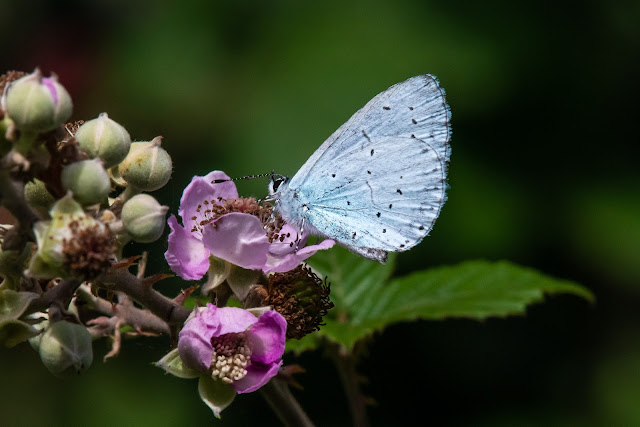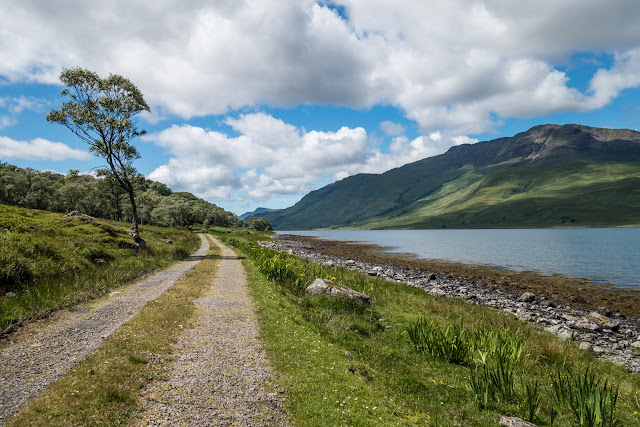Wasp Spiders in Landseer Park, Ipswich
In 2019 we found and photographed a wasp spider at RSPB Minsmere. What a fascinating looking spider! So, this year, we thought we would try and find another one and obtain some more photographs. Having recently been alerted to a sighting in Landseer Park in Ipswich, this seemed an obvious starting point, especially as there was a good chance of some butterflies in Piper`s Vale, almost opposite.
The day started a bit dull as we started our walk around Piper`s Way but we were not to be disappointed as we found a patch of blackberry brambles which seemed to be the `patch` of some Holly Blue butterflies.
Two images of this gorgeous Holly Blue
The holly blue is a small blue butterfly that emerges in early spring, from March to May, and then again at the end of the summer between July and September. This is the blue butterfly most likely to be found in gardens, as well as woodlands, parks and churchyards. It tends to fly high around bushes and trees, whereas other grassland blue butterflies fly low to the ground. The foodplants of the caterpillars are mainly Holly (for the spring generation) and Ivy (for the summer generation), although a wide range of other plants are used including spindle, bramble and gorse. This one was flying over a large blackberry bush area.
Comma - Polygonia c-album
The Comma is a fascinating butterfly. The scalloped edges and cryptic colouring of the wings conceal hibernating adults amongst dead leaves, while the larvae, flecked with brown and white markings, bear close resemblance to bird droppings.
The species has a flexible life cycle, which allows it to capitalize on favourable weather conditions. However, the most remarkable feature of the Comma has been its severe decline in the twentieth century and subsequent comeback. It is now widespread in southern Britain and its range is expanding northwards. This one appeared to be in good condition, I thought, as it settled close to us.
Common garden spider
Wasp Spider Argiope bruennichi
Then to the Wasp spider. We entered Landseer park from the car park, and started searching on the right hand side of the pathway. So not many meters from the gate. Within 15 minutes, Rosey had found three separate webs with Wasp spiders! I think you could say we were pleased!
The underside showing the spinnerets
One of the main thing that distinguishes spiders from the rest of the animal kingdom is their ability to spin silk, an extremely strong fiber. A few insects produce similar material (silkworms, for example), but nothing comes close to the spinning capabilities of spiders. Most species build their entire lives around this unique ability.
Scientists don't know exactly how spiders form silk, but they do have a basic idea of the spinning process. Spiders have special glands that secrete silk proteins (made up of chains of amino acids), which are dissolved in a water-based solution. The spider pushes the liquid solution through long ducts, leading to microscopic spigots on the spider's spinnerets. Spiders typically have two or three spinneret pairs, located at the rear of the abdomen.
Wasp spiders are a very distinctive looking species. They have black and yellow stripes across their bodies, looking like no other species of spider found in the UK. Their colour and pattern mimics the colouration of a wasp, which is where the Wasp spider gets its name from. Their appearance is actually a defence mechanism, as by disguising themselves as wasps, predators leave well alone believing them to be a wasp and not a spider. Clever! Their bright appearance may seem dangerous, but don’t be fooled as these mesmerising little creatures are actually harmless! And in fact are related to the Common garden spider.
To match their unique look, Wasp spiders also have a unique web. They are orb-shaped, like a Common garden spider, but they have a single zig-zag pattern of silk through the centre rather than all over. Their webs aren’t always like this. When Wasp spiders are young, their web is a circular zigzagging design. When the spider grows older, it makes both the circular and straight zigzag pattern through its web, until it eventually only makes the straight zigzag pattern.
The zigzag design is created to reflect UV light and attract pollinating insects like flies, bees and moths! - so it is now thought.
As is the case with many spider species, the females rule the roost!-Or web in this case! Female Wasp spiders are much larger than males, measuring in at an impressive 14-17mm, whilst males only reach up to between 4 and 6mm. When it comes to mating, males play a daring and dangerous game. Males will wait at the edge of a web until the female has moulted into a mature form then will dive in to make their move. Females actually eat males whilst they are mating, so doing it at this precise moment is key to the hopeful survival of males as the female’s jaws are still soft. However, luck isn’t on their side much and the females still eat the males alive, soft jaws or not!
Wasp spiders are mainly found in grasslands but can also be present in coastal areas, farmland, heathland, woodland, towns and gardens.










Comments